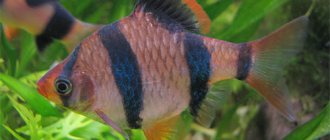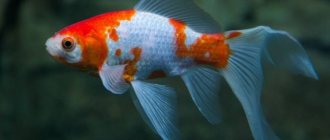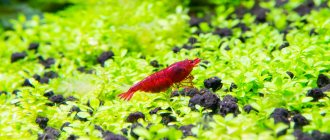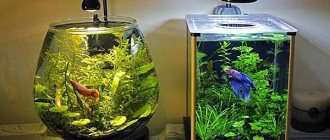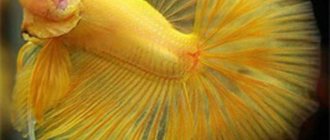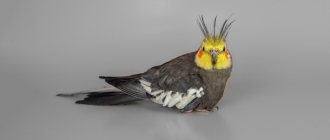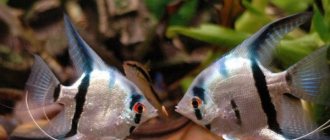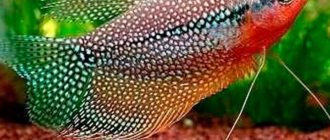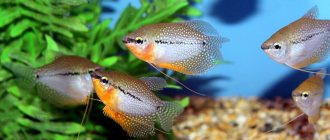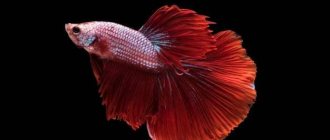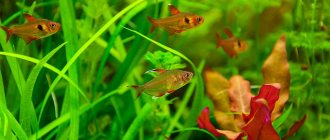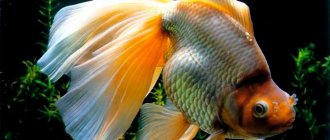Cockerel fish: how to distinguish a female from a male
The body of the fish has the shape of a slightly elongated oval, slightly compressed at the sides.
Males reach 5 cm in length, females, of course, lag behind them and grow to a maximum of 4 cm. The cockerel is an amazing fish, fabulous in color. Their scales, perhaps, have no equal in the depth and brightness of colors. At the slightest movement of the cockerel, the blue, red, pink, green, yellow and orange colors of its body “break”, playing in the light with fantastic shades. Angry males acquire a special color when they sort things out. During the spawning period, the color of the betta also becomes deeper. Females are slightly inferior to gentlemen in the brightness of colors, and their fins are not so chic. True, when breeders came close to this issue, female cockerels acquired long fins and became almost as bright as the males.
The transverse and longitudinal parts of the cockerel's body are marked with dark stripes. The upper fin and tail of the fish are neatly rounded, and the lower fin is very long - from head to tail. The fins on the chest end with sharp edges. When the cockerel is very excited, it inflates its gills like a protruding collar framing its head.
Understanding where the cockerel is and where the “hen” is will not be difficult even for a novice aquarist. Males are naturally more graceful and colorful, and have more “sweeping” fins. Females are small, with not very long fins. However, this is not the main difference between the individuals. You can unmistakably identify a female by the presence of a small white speck in her anus.
Those for whom breeding cockerels as a means of earning money or as a kind of hobby need to know how to determine the sex and distinguish a male from a female. This is not difficult to do, since there are a number of differences between them, which can be noticed when the fry of betta fish have reached the age of 3 months.
Under normal conditions of existence, males of this species look much “more elegant” and brighter than females. However, if females, for one reason or another, experience stress associated with moving or human intervention, the intensity of their color may change and not be inferior in brightness to the color of the male, and then it will not be possible to determine the sex based on this characteristic.
Breeding cockerels
Breeders who have bettas need to know that the reproduction of these aquarium fish is possible if certain conditions are created for them. This process contains the following steps:
- Pair selection.
- Preparing for spawning.
- Betta fish spawning.
- Caring for the fry.
In order for the fish to begin spawning and reproduce successfully, it is necessary to approach each stage responsibly.
Pair selection
For reproduction, it is important to choose the right pair for the fish. Cockerels aged 5-6 months, but not older than one and a half years, are best suited for these purposes. The fact is that individuals who have lived more than 16-18 months often have problems with reproductive abilities. In such cases, betta fish fry are born with defects and the mortality rate is high.
If there is only one betta fish in the aquarium, but further reproduction is planned, a pair will need to be purchased from a breeder with a good reputation. It is not worth purchasing a male or female in a pet store, since sellers may not have information about the exact age or may deliberately mislead the buyer.
Betta fish spawn and reproduce without any problems if certain conditions are created for them. First of all, you will need to equip a spawning aquarium, which must meet the following requirements:
- have sufficient capacity and hold 40–50 liters of water;
- have a partition to create two places in the tank, for a male and a female;
- be suitable for placing aquarium shelters and planting floating plants.
To create favorable conditions for the fish, you will need to equip the spawning tank with a sponge filter and a heating device. For the fish to feel comfortable, the water temperature should be 27-28 degrees. It is not recommended to pour a lot of water into the tank; it is enough to fill it to 12-15 cm and place it in a quiet place.
In addition to aquarium equipment, successful breeding also requires proper feeding of the bettas. 14 days before the start of spawning, they should receive “live” food such as:
- worms;
- crickets;
- cockroaches;
- bloodworm;
- Artemia.
Before consuming insects, you will need to chop them up and feed the fish in such quantities that they are able to eat in order to avoid clogging the aquatic environment.
It is important to pay attention to the behavior of the bettas. A sign that individuals are showing interest in each other is considered to be an excited state and a demonstration of their own appearance when they straighten their fins and gill covers. But if the fish are aggressive, you will need to choose another pair for the female and male.
Spawning
Since cockerels are fish with a character that can show aggression towards their fellows, the spawning process looks unusual. First, the male builds a nest of air bubbles. To do this, it swallows oxygen and then spits it out, resulting in a lump of foam. The eggs of betta fish are stored here and the fry are kept until a certain time.
Before the start of spawning, the male individual behaves aggressively towards the partner, striking her. Then changes occur in the ritual dance when the pregnant female shows her partner imaginary eggs on her stomach, which provokes a new attack. The male wraps himself around his partner, putting pressure on the abdomen, which causes the release of eggs and milk.
Watch a video about preparing fish for spawning.
Caring for fry
Cockerel fry are not known for their survival rate, and therefore the care and maintenance of the fry requires a special approach. First of all, you will need to take care of the food in advance, which must be prepared 1-2 weeks before the appearance of the fry. The following is used as feed:
- ciliates;
- vinegar eel
- Artemia.
After 10-14 days, a microworm and finely chopped tubifex are added to the diet of the young animals. In addition to proper nutrition, it is necessary to take care of the comfortable conditions for keeping the young animals. This requires:
- Equip the aquarium with a compressor, since the respiratory organ is finally formed in fish only at the age of 20-22 days.
- Gradually reduce the temperature of the aquatic environment to 22-24 degrees.
- Replace 4/5 of the water volume daily.
- After 3 weeks, transfer the fry to a spacious vessel with a volume of 100 liters.
When the fry reach the age of 3 months, their sex can be determined with accuracy. And after six months the fish are already capable of reproduction.
If you follow the above rules and recommendations, breeding cockerels at home will not cause any difficulties even for a novice aquarist.
Watch a video about breeding cockerels.
There are quite a lot of them. The first thing to consider is age. Life expectancy for this species is limited to 3 years. In this case, puberty occurs already at 3-4 months. From this time on, the females can already discern eggs in their stomachs, and after 2 weeks they are ready to lay them. Many species, once ready to spawn, acquire noticeable stripes along the body. Typically, pet stores sell fish at this age.
The male cockerel is not only beautifully colored, but has wide fins - lateral, anal and caudal. In the official classification, it is customary to distinguish between varieties: long-tailed, short-tailed, crown-tailed, veiled-tailed and others. The difference between them is visible to the naked eye. The first one is the most spectacular. Aquarists achieve by crossing the unusual combinations of shapes and colors of this fighting species.
An excited and aggressive cockerel is a stunning sight. The fins floating in the water take up as much or even more space around him than his body. The female is much more modest in color and size; her fins do not have such a decorative function. But the main difference is considered to be a small growth on her belly (ovipositor), similar to a white egg; the male has nothing similar.
You can visually identify a male or female from the age of three months. There are several signs that distinguish a female betta fish from a male:
- Female betta fish are slightly smaller in size than males.
- The male individual is distinguished by a luxurious tail, and long fins, reminiscent of sails, with a brighter color in comparison with the fins of chickens.
Interesting: If a female cockerel was under stress, for example due to a change in environment, her color may become as bright as that of a male. In this case, it is almost impossible to determine the gender of the fish.
- The female, as a rule, is calmer than the self-confident and aggressive male.
We suggest you read: How to stop a cat from pooping in the litter box
Important! During the spawning period, the male betta fish becomes more hostile to its direct competitors and to fish of other species. To avoid collisions and fights, it is necessary to create hiding places in the aquarium.
- On the belly of the female there is a small white formation similar to an egg.
Yellow cockerel
External differences in cockerel fish begin to appear only at four months of age. Males begin to grow longer fins and a tail. Differences in size also become noticeable: males become larger and more massive. But in some short-tailed species (for example, poster bettas), it is difficult to navigate by the size of the fins. There is one external difference that is noticeable even in young fish.
In the photo, how to distinguish male and female betta fish is clearly visible: the pelvic fin of the male is always thin and long, while in the female it is wider and round. Females also have a more rounded abdomen and often have a distinct white dot visible on their belly. Although young males may also have a white dot on their abdomen before reaching maturity.
Cockerel fish: maintenance, compatibility, reproduction, photo-video review
Amazingly beautiful, beautiful, unpretentious, daring - all these words can be applied to the aquarium fish betta. Aquarium bettas have bright, variable colors. Males of almost all types of bettas have luxurious, veil-like fins. And their maintenance and breeding does not present any difficulty.
This is why bettas are one of the most popular fish among beginners in the aquarium world, as well as among professionals who keep beautiful breeding forms and enter them into competitions.
To understand all the beauty and character of these fish, below I will give a literary description of the behavior of betta fish in nature, from the book by I. Sheremetyev: “Along with the beautifully colored gourami, the grayish-greenish fish is not immediately noticeable. Its body is 6 cm long, slightly laterally compressed, elongated. On the sides there are dull longitudinal stripes with a greenish sheen.
And then the same gray, inconspicuous fish approached the fish. And suddenly, as if something flashed and shone in the small body. The body and spread fins became emerald. The fish opens its gill covers and sets off to meet the guest. The fish can determine whether it is a female or a rival male only by seeing how the stranger responds.
The female is in front of the magnificent male, submitting, spreading her fins. If she is not ready to spawn, she immediately flees. If two males meet, their intentions will be more serious than one might imagine. Mutual posing begins, demonstrating brightness, playing with shine and fin sizes.
This can last a few minutes or sometimes an hour. If one fish turns out to be half the size of the second, then it leaves someone else's area. But, if the males are the same size, then sooner or later the first blow will be made! Within minutes of the start of the fight, the fins of the weaker male hang in shreds, the gill covers are broken, and bloody wounds cover the body.
We invite you to read: Fospasim for cats: description, instructions for use, composition and release form
Beautiful, professional photo of a betta fish
Let's take a closer look at these amazing representatives of South Asian reservoirs.
Latin name: Betta splendens;
Russian name: Cockerel fish, Siamese cockerel, cockerel, chicken, betta, fighting fish;
Order, suborder, family, subfamily, genus: Perciformes – Perciformes, Anabantoidei, Osphronemidae, Macropodusinae, Betta
Comfortable water temperature: 25-28 °C.
“Acidity” Ph: not particularly important, but comfortable 6-8;
Hardness dH: doesn’t really matter, but comfortable 5-15°;
Aggressiveness: Bettas are relatively peaceful fish - they cannot be called predators. However, they exhibit strong intraspecific aggression and territoriality. It is not possible to keep two males in a small aquarium. The dominant male will definitely kill the weaker one. Two or more males can only be kept in large and wide aquariums, but fights for territory and females still cannot be avoided. In addition, males often show aggression towards a female they “don’t like” during spawning.
Content difficulty: easy;
Compatibility of betta fish: in addition to the previously mentioned intraspecific aggression, fish aggression applies to all small, clumsy and veiled fish. Therefore, they can only be kept as nimble, active fish that are similar in size. As a recommendation, you can recommend the following for your bettas as neighbors: corydoras (speckled catfish), zebrafish, molynesia, swordtails, other nimble platies, tetras.
Bettas are not compatible with cichlids, a family of goldfish, and other labyrinth fish are not desirable. They are also not compatible with snails; they eat small ones, but tear off the whiskers of large ones.
In addition, when combining fish, you should always take into account the similarity of keeping conditions and water parameters; for more information about the compatibility of aquarium fish, see HERE!
How long do they live: betta fish are not long-lived in aquariums; their lifespan is short - only 3 years. You can find out how long other fish live HERE!
Origin
The betta fish has its origins in Thailand, Indonesia and Vietnam. There, these aquatic inhabitants live in small warm ponds. Therefore, the optimal water temperature for this species is 22-26 degrees. The silty, standing waters of Southeast Asia are low in oxygen. Therefore, your aquarium will not need an aerator to saturate the water with oxygen.
At home, no one is particularly interested in what color the betta fish is. Their content boils down to preparation for battles. Special trainers do this. A huge number of spectators come to watch the fights. However, most often the death of the fish is not allowed; torn fins are enough.
Description
The betta fish has an oval, elongated body, slightly compressed at the sides. Its length is up to 5 cm in males and smaller, up to 4 cm, in females. In terms of beauty and brightness, the “fabulousness” of coloring, they have no equal. At any turn, red, yellow, orange, pink, green colors sparkle and play, taking on all sorts of shades. The color of males is especially bright when they clash with each other.
During spawning, the betta fish also “fills up” with paint. The females are a little paler than their gentlemen; the fins of the “ladies” are short and not so luxurious. However, breeders are working in this direction. Not so long ago, females appeared whose fins have a more elongated shape, and the body color is not inferior to males.
The betta fish has dark stripes across or along its body. The upper fin and tail of this species are rounded, the lower fin, starting from the head, reaches the tail. The pectoral fins of bettas have a pointed shape. It is interesting to watch fish that are excited - the gills of males swell, forming a protruding “collar” around the head.
The sex differences in these fish are obvious. The “boy” cockerel is slimmer, it is brighter in color, and its fins are much longer. Females are usually smaller and have shorter fins. The main difference between a “hen” and a cockerel will be the presence of a small white speck – a “grain” – near the anus of a female individual. This formation is a bit like an “egg” coming out. It becomes clearly visible from the age of three months.
What else do you need to know after you have betta fish in your home? Maintaining them is not such a difficult task.
Content
You don't need academic knowledge or special conditions to own a betta fish. This species feels great even in a small aquarium. Some owners manage to keep one individual in an ordinary three-liter jar. But two males cannot get along in one “reservoir”.
True, some owners separate long aquariums with glass, placing their pets one at a time in different compartments. Many people also do this because, seeing an opponent, the cockerels begin to become brighter, more colorful, they take warlike poses, trying to frighten and intimidate their counterpart. Females are not so aggressive; several of them can be kept at a time.
Betta fish at home can live in an aquarium at the same time as other species. However, it is worth avoiding neighbors with veil fins. Otherwise, the “fighters” will certainly cut them off. It is better to place larger fish with short fins, such as barbs, with the cockerels.
For tropical bettas, it is advisable to maintain the water temperature in the range of 24 to 28 degrees. It is allowed to periodically reduce it to 18 degrees. Open areas should be left on the surface of the water, without floating vegetation. Fish need atmospheric air. There is no need for special aeration of the water, but it is advisable to pass the water through a filter. It is recommended to place the aquarium in such a way that it receives sunlight for several hours during the day. It is not advisable to place it in a draft.
The pond should be thoroughly cleaned periodically. To do this, you should either partially or completely change the water. The fish are first caught with a special net and placed in a jar. Sanitation is carried out without the use of powders.
Air
The labyrinth organ is a distinctive feature of betta fish. This is not a simple addition to the gills - these babies breathe atmospheric air. Make sure that the surface of the water does not become overgrown. Sometimes a bacterial film appears on it; it can be easily removed if you apply a sheet of paper to the water, and then simply carefully remove it.
Cockerels can jump out a lot. To prevent them from harming themselves, install a special cover with holes or a mesh.
The fish will need soft water. Do not use distillate for the aquarium, as it contains not only harmful, but also beneficial substances. Specialized stores sell special preparations for softening and purifying water. Temperature should be controlled. To slightly reduce aggression and stress, add a little therapeutic and prophylactic salt (half a teaspoon per four liters).
We suggest you read: Newborn ducklings, how to distinguish a duck from a drake
Feeding
What to feed betta fish? These aquatic inhabitants are not picky. They can eat both dry food and live food. Most of all, cockerels love bloodworms. You can give tubifex, cyclops, daphnia. Earthworms will do. To prevent the fish from overeating, remove uneaten leftovers 15 minutes after the start of feeding. Food should be given once or twice a day.
If you see that your pets are overeating, give them one fasting day a week.
As stated earlier, male bettas should not be kept together. It is also undesirable to keep individuals of different sexes together. The male will constantly chase and bully the female.
Is this the first time a betta fish has appeared in your home? “Who does this species get along with?” - this is a question often asked by beginners. Despite their “fighting” glory, the cockerels behave quite peacefully towards their neighbors. Sometimes, however, a male can attack a male guppy, mistaking him for a relative.
Features of keeping cockerels
And today, the shallow rivers of Thailand and other Asian countries remain places for catching betta fish. The elongated oval bodies of males with fantastically bright colors swelled up like balls before attacking their opponent. This is what once attracted people's attention to them. Since ancient times, this species was caught by peasants for fish fights, one of the most common gambling entertainments in those places.
· When one of the opponents needs to rise to the surface of the water for a sip of oxygen, the second one patiently waits for him without attacking.
· While two people are fighting, the others do not interfere. The winner fights the following contenders in order.
The fish reach their largest size - 10 cm in length - only in their natural habitat, rarely reaching such sizes in an aquarium. The usual body length is about 5-6 cm. The color can be any, but it is always very bright and conspicuous.
Betta fish belong to the labyrinth species, and are attractive due to their unusual appearance and behavioral characteristics. The distinctive features include the following:
- These fish do not need a large aquarium; they are able to live and reproduce in small containers. A male or female betta is content with one liter of water.
- Fish of this variety do not need additional sources of oxygen, so there is no need to install compressors. This is due to the fact that cockerels have an organ called a labyrinth, which allows them to breathe air.
- The reproduction and mating games of betta fish is a surprisingly fascinating spectacle that deserves special attention and requires the creation of certain conditions.
These qualities have allowed betta fish to become popular among beginners and experienced aquarists.
All species of labyrinth fish are native to swampy lakes and slow, shallow rivers of Africa and Southeast Asia. During the hot season, the water level in such reservoirs decreases sharply, and the oxygen content in swampy water also becomes very low. To survive in such uncomfortable conditions, the ancestors of labyrinthine fish developed a special organ that allowed them to breathe atmospheric air. This organ, called the labyrinth, is located in the head of the fish and consists of a series of plates penetrated by blood vessels.
It is this feature of all labyrinth fish, including betta fish, that makes them the most unpretentious inhabitants of home aquariums.
Like all labyrinth fish, bettas can breathe in two ways. They can absorb oxygen dissolved in water, or they can breathe atmospheric air, capturing it from the surface of the water.
Therefore, if only males will live in the aquarium, you do not need to install an aeration system. But the aquarium must be covered with a lid and a space of at least 15 cm high must be left between the water and the lid. This will allow the fish to breathe air at a suitable temperature and prevent active males from jumping out of the aquarium. This is another sign of how to distinguish a male from a female in a betta fish - the behavior of females is much calmer, and they almost never try to jump out.
Keeping fish of this breed will not require specific conditions or too much effort on your part. Even a very “modest” sized aquarium is suitable for cockerels. One individual will be able to settle in and decorate even an ordinary three-liter jar! But don’t think that this “trick” can be done with two males.
Boy bettas are bitter rivals, and when they are out of sorts, the whole aquarium is upside down. Some owners of long aquariums divide their home ponds with glass partitions into separate compartments, in each of which they place one male pet. At the sight of an opponent, the fish “fills up” with paint, effectively bristling its fins, but cannot harm its counterpart.
More peaceful females do not refuse to live in an aquarium with a “female” team. At home, cockerels can be kept simultaneously with fish of other breeds. However, make sure that the bullies do not have neighbors with lush veil fins: the cockerels will not miss the opportunity to tear off this beauty. Barbs are ideal for living together with bright fighters. This short-finned breed is larger and more powerful than bettas.
The water temperature in the aquarium where lively fish live can vary from 23 to 28 degrees. Periodically it can be lowered to 18 degrees. Make sure that floating vegetation does not cover the entire surface of the water - there should be open areas for free access of atmospheric air.
As the water in a home pond becomes contaminated, it is completely replaced with new water. The cockerels caught using a net are placed in a jar. The walls of the aquarium are cleaned without using any cleaning agents!
One of the distinctive features of the betta is that the fish can breathe atmospheric air, since it has a special labyrinth organ. In this regard, it is necessary to monitor the cleanliness of the water surface, where the so-called bacterial film sometimes appears. The harmful formation can be quickly removed by applying a sheet of paper to the water surface and then carefully removing it. Cockerels are very active fish; they can even jump out of the water and die if you do not cover the aquarium with a special lid with holes.
Features of the fish
The fish has interesting features that make it so popular for keeping at home:
- The volume of an aquarium for a betta can be extremely small; an individual will survive even in 1 liter of water (but it is not recommended, because the fish will feel uncomfortable).
- To raise bettas, you do not need an air generator; this species has a unique labyrinth organ that allows them to breathe atmospheric air, so this individual is suitable for keeping in the bedroom and other rooms where you do not want to hear the sound of a running compressor.
- Betta individuals perform interesting and beautiful games during the mating season.
- In order for the female and male rooster to reproduce, they need to create appropriate conditions.
The general requirements for keeping individuals include an optimal water temperature of 27 degrees, acidity from 6.5 to 7.3. Hard old water is not suitable for these fish.
Matching
The appearance and beauty of the future offspring depend on the correct selection of a pair of betta fish. There are several recommendations:
- Pairs of the same breed are used for breeding.
- To ensure that the color of the new generation of bettas is uniform, you should choose fish of the same color.
- The female and male should be similar in size.
- When choosing a pair for breeding, you need to take into account that the age of both fish is in the range from 5 months (considered sexually mature) to one and a half years. The older the betta fish gets, the higher the likelihood of problems occurring during breeding - possible birth defects in the fry.
Important! It is better to buy betta fish for breeding from professional breeders rather than in pet stores. Since in the second case there is a chance to acquire a fish unsuitable for reproduction.
- Before crossing, you need to make sure that the pair is healthy. To do this, you should pay attention to the presence of the following signs: cloudy eyes; incompleteness of fins; presence of wounds on the body; decreased overall activity; poor appetite; faded color of scales. The detection of one or more signs should alert the owner and serve as a signal to contact a veterinarian.
- A couple that has been selected for breeding must get to know and get used to each other. Due to the fact that males sometimes behave quite aggressively, the introduction procedure is carried out by placing the fish in an aquarium with a transparent partition installed in the middle. Ideally, it is better to place a cockerel in an aquarium with a hen, since in its own territory, it will feel like a full-fledged owner, and in an unfamiliar environment it will become a little more peaceful.
Important! If both fish have the same defect, for example, uneven scales, there is a very high probability that the same feature will appear in the fry.
There is no guarantee that the first, even carefully selected, beautiful pair of betta fish will like each other. There are several behavioral signs that are easy to notice if the dating stage is successful:
- Attempts to attract the attention of the female by demonstrating the beauty of bright fins and a long tail.
- Excited, but not aggressive behavior on the part of the male.
If within a few days the couple does not show mutual interest in each other, you should try to choose another female for the cockerel.
Red and blue cockerel
Betta betta fish
These bright fish with beautiful veil fins were called cockerels for a reason. Male cockerels are outright bullies; they do not tolerate rivalry and attacks on their territory. Observing their behavior, it becomes clear how to distinguish a female betta fish from a male. The male is very self-confident; having noticed an opponent, he immediately straightens his fins, trying to appear larger and changes his color to a brighter one.
We invite you to read: Detailed description of Turkish Van cats
Female bettas are always less brightly colored and do not have such luxurious long fins. This is one of the main signs by which it is visually clear how to distinguish a female betta fish from a male.
Female and male: differences
You can visually identify a male or female from the age of three months. There are several signs that distinguish a female betta fish from a male:
- Female betta fish are slightly smaller in size than males.
- The male individual is distinguished by a luxurious tail, and long fins, reminiscent of sails, with a brighter color in comparison with the fins of chickens.
Interesting: If a female cockerel was under stress, for example due to a change in environment, her color may become as bright as that of a male. In this case, it is almost impossible to determine the gender of the fish.
- The female, as a rule, is calmer than the self-confident and aggressive male.
Important! During the spawning period, the male betta fish becomes more hostile to its direct competitors and to fish of other species. To avoid collisions and fights, it is necessary to create hiding places in the aquarium.
- On the belly of the female there is a small white formation similar to an egg.
Yellow cockerel
Preparing for spawning
Breeding betta fish at home is not difficult and can be done by a beginner in the aquarium business. However, for a successful outcome of the event, the aquarium owner will need to comply with certain conditions:
- For spawning, a special aquarium with a volume of 15 to 40 liters and a height of at least 15 cm is prepared.
- A partition is installed inside such an aquarium so that the male and female can be separated.
- Care should be taken to arrange places where the female can hide from the temperamental cockerel while the partition is removed.
Important! You can determine the time for spawning by the appearance of the female - the abdomen is noticeably rounded.
- It is necessary to provide a sponge filter and a water heating system in the sedimentation tank.
- In the spawning tank, the temperature is maintained in the range from 26 to 28° and the water acidity level is from 6 to 7.5 pH.
- 1.5 - 2 weeks before the start of spawning, live food is added to the daily diet of the female and male. It is preferable to feed bloodworms.
Important! The aquarium must be kept clean, so uneaten food should be removed promptly.
- There should be no soil in the container where spawning will take place. The presence of stones can create a situation where eggs fall between them, and they can easily get lost in the sand.
- The future father himself is engaged in building a nest for his offspring. The cockerel swallows a small amount of oxygen and spits it out. The result is foam from small bubbles that are well attached to each other. The male makes a nest from them. You can place a small amount of small floating algae on the surface of the water (placing pistia and other analogues would be a good option) or pieces of foam - this will also serve as a good building material for the nest.
Important! The female needs preventive spawning to maintain health, even if the owner of the aquarium did not intend to breed Siamese bettas.
Types of betta fish
All the bright colorful varieties of aquarium beauties bettas are descended from their wild counterpart, a nondescript dark olive-colored fish. Sometimes dark stripes and spots were added to the green coloration of wild cockerels.
As a result of long selection, more than 40 different species of betta fish were bred. They differ in different colors, sizes of dorsal and pectoral fins. The size of the fish themselves and even the shape of their body can be different.
But no matter what breed the cockerel is, how to distinguish a female from a male is always clear. Female bettas are smaller in size, always more modestly colored and are not at all aggressive towards members of their species, or towards other fish either.
Reproduction of cockerels
Many eyewitnesses compare the very process of breeding cockerels in an aquarium to some kind of unusual dance.
The cockerel, as a rule, behaves quite aggressively towards the female. Until the moment when the fish begins to spawn, the male chases it around the aquarium for some time and periodically strikes it. These actions of the cockerel allow him to achieve the level of arousal that is necessary for procreation.
Cockerel in a small aquarium
Interesting: Watching how betta fish reproduce, it can be noted that the hen does not stand sideways to the temperamental partner, because in this case it is easy to get injured.
The behavior of the male and female changes at the moment when the chicken fish shows the cockerel a light dot on its belly, similar to an egg. After this action, the next stage of the breeding process begins - hugging.
The male beats the female. By pressing on her stomach, he provokes the release of milk and white eggs into the water. Such hugs can be repeated several times. It is interesting to watch how the cockerel quickly and deftly picks up the eggs and carries them to the nest. The activity and speed of the male contrasts sharply with the immobility of the female herself, who remains in such a frozen state until the end of spawning.
Interesting: On average, after successful spawning, males may produce about 500 eggs.
After all the eggs have been transferred to the nest, it is recommended to place the tired female in another container or place a partition in the aquarium, since an energetic male can harm the female.
Next comes the incubation period. At this time, the small bubbles that make up the nest begin to burst. The task of the newly minted father of the family is to “repair” damaged areas in a timely manner and return the eggs that have fallen from the nest to their place. The duration of this period, as a rule, does not exceed 5-6 days.
Its completion and transition to the next stage will be marked by the appearance of larvae. At this point, the best solution would be to place the male in another aquarium so that he does not harm the fry.
Reviews from cockerel owners
Natalya, review of the Siamese cockerel “Siamese Crown”
An unpretentious, beautiful, interesting and leisurely fish.
Can tear off or bite guppy fins if they spin in front of his nose for a very long time; eats fry (in my situation this is not a drawback, only the strongest and quickest fry remain) If the male cannot treat the female correctly and she is unable to sweep away, then the female becomes aggressive and can tear off the male’s fins. (In my case, three females “shaved” the male very short, so I don’t keep females)
I really like these beautiful fish. Contain a population of livebearers within limits. It is better to keep males separately, even from females, if breeding is not the purpose of keeping these fish. Amano does not touch shrimp, but he can most likely eat other, smaller ones.
Maxim, review of the Siamese cockerel “Siamese Crown”
Very beautiful males. Suitable for nano-aquariums (don't forget about water changes!). Undemanding to water quality. Safe for small, active fish (Venezuela guppies, neons). Males practically do not get along with each other and constantly fight. Often to death, until the stronger one pecks the weaker one. It is better to keep them in different aquariums, although if you place two jars side by side, you can watch beautiful dances when both begin to cock each other) They eat shrimp - they are contraindicated for the shrimper.
For an aquarium of 10 liters or more, you can take a male and a female or a male and two females. As soon as the male builds a nest of riccia and foam from his own saliva and forces the female to lay eggs there, it is better to place the girl - then the boy will take care of the children himself. Mating games and the process of nurturing offspring is a very colorful reality show, useful for children and adults, especially for dads))
Komilfo Roman, review of the Siamese cockerel "Half Moon"
Amazing fish! If you survive the first week, then you will live until old age. Or until you add a new sick fish :).
I already have three superdeltas, sitting in the same aquarium with partitions. When I have time to work with them, I lift the curtains (plastic) and admire))
The most popular types of betta fish
Thanks to many years of selection, there are many varieties of betta fish. But some of them are most commonly found in home aquariums.
- Veiled bettas are probably the most popular species. Their luxurious fins and tail most resemble a luxurious fluttering veil. The color of the scales of this type of cockerel can be very different (blue, red, emerald, even white), most often single-colored individuals are found. It is very easy to understand, looking at a veiled betta fish, how to distinguish a female from a male: the female never has such long fins.
- The double-tailed cockerel is distinguished by double dorsal and caudal fins. The fish of this species are very beautiful; their fins shimmer in different colors in bright light. It is not recommended to house them with active aggressive fish of other species, which may mistake their luxurious fins for prey and bite the tips.
- Royal, or giant, cockerel. This is the largest variety of betta fish, males can grow up to 7.5 cm. These cockerels have fins and a tail of almost normal size, therefore, how to distinguish a female from a male betta fish is not always clear. Differences will only appear in the intensity of color and behavior - females are more peaceful.
- The halfmoon, or crescent-tailed betta, is a gorgeous, brightly colored fish whose spread fins resemble a crescent moon.
The colors of betta fish are simply incredibly diverse: green, red, blue, purple - the variety of colors is endless. In addition, stunningly beautiful two-colored cockerels were bred, with a body of one color and fins of another.
Cockerels of the so-called dragon color look very unusual: they have a single-color body, most often red, and their scales have a pronounced metallic (silver or golden) tint. In the light of aquarium lamps, such a handsome man looks fantastic!
How to distinguish a male from a female in a betta fish and how do they differ? All the above characteristics of bright scales, various colors and beautiful long fins apply only to male bettas. For many years now, aquarium enthusiasts have been trying to breed a breed of cockerels where the females are at least closer to the males in brightness of color, but they are not succeeding. Female betta fish have no distinct species differences at all and are very inconspicuous.
What to do next?
In order for the fry of these fighting fish to grow and become excellent representatives of their breed, care must be taken to create comfortable conditions for their development.
Recommendations for caring for betta fish at home:
- Feeding. Food for the fry should be prepared before they appear. In the first days, the menu welcomes the presence of brine shrimp, vinegar eels and ciliates. After a couple of weeks, tubifex is added to the daily diet, which is cut as finely as possible before feeding.
- Aquarium. The container in which it is planned to keep the fry must be equipped with a compressor. It is recommended to maintain the water temperature in the range from 22 to 24°. Since the temperature in the spawning area was 4-5° higher, then after the fry move to a new place, the temperature should drop gradually. It is necessary to refresh the water every day, replacing ¾ of the liquid of the total volume. 4-week-old fry are transplanted into a spacious aquarium.
- Life in a new aquarium. Until the moment when a small cockerel turns into a worthy representative of its breed, it can arouse increased interest among larger fish as food. Therefore, it is not recommended to transplant young specimens into an aquarium with pugnacious, overly active and predatory fish neighbors.
We invite you to read: Description and characteristics of bee breeds
Caring for fry
Betta fry require careful care as they are not known for their survival rate. The food should be prepared a week before the fry appear.
For food you will need:
After two weeks, you need to add a microworm and chopped tubifex to the food. In addition to a properly formulated diet, it is necessary to create comfortable conditions for the development of young animals:
- The aquarium must be equipped with a compressor, since until the age of 20 days, the young animals have not yet formed a respiratory organ;
- The water temperature must be gradually reduced to 22 degrees;
- It is important to perform water changes daily.
As soon as the young animals reach the age of 3 weeks, they must be moved to a spacious aquarium. When the bettas are 3 months old, the betta fish can be distinguished by sex and prepared for spawning again.
Keeping betta fish in captivity
Breeding experience shows that it is impossible to place several males in one aquarium at once. Females can be kept in schools, but separately from the male. A good choice is a male-female pair. Theoretically, if the aquarium capacity is more than 10 liters, then two males can divide this territory between themselves. However, this is rarely done, since in large containers the fins can become deformed and the fish will lose its decorative effect. This is explained by the fact that in its natural habitat, it settles in shallow rivers.
The range of comfortable water temperatures ranges from 18 to 24 degrees. However, at home it is recommended to maintain it at about 22-23 degrees. pH level ranges from 6.7 to 7.3. This mode is optimal for active life and reproduction. The capacity of the aquarium is selected at the rate of 3-4 liters for each individual.
Betta fish are a lungfish species, so they do not require artificial aeration. They are much more demanding about the purity of water and the environment. The recommended frequency of water changes is 2-3 weeks, since the accumulation of sludge at the bottom is unacceptable for these cleaners. Algae must grow at the bottom. Lighting is selected according to the choice of plants.
Cockerels can rightfully be called the most unpretentious aquarium inhabitants, even among labyrinth fish. Caring for them will not cause any trouble even for a completely inexperienced aquarist.
However, this does not mean that there is no need to create suitable conditions for them. Many sellers in pet stores assure customers that a betta fish can live even in a small plastic cup. Maybe, but not for long...
Like any fish, a betta must be able to swim to live. The minimum volume of an aquarium for keeping one betta is no less than five liters. And watching only one fish will be uninteresting even for a child.
Despite the myths about the convenience of round aquariums, low, no higher than 50 cm, rectangular containers are more suitable for bettas. It is advisable that the aquarium be planted and have several shelters where frightened inhabitants can hide.
If you plan to place several betta fish in the aquarium, it is better to choose one (maximum two) males and several females. It is better to buy fish very young; growing up together in the same aquarium, they will be more tolerant of each other. In young cockerels, external differences between the sexes are not yet very pronounced. Observing the behavior of juveniles will help you understand how to distinguish a female from a male in a betta fish.
Breeding aquarium bettas is not at all difficult; sometimes replacing the water with fresh water or a slight change in temperature is enough to stimulate spawning.
When breeding betta fish, the differences between the female and the male are more than noticeable. Surprisingly, females play a minor role.
The male himself builds a nest of air bubbles on the surface of the water, holding it together with saliva for strength. Small plants that float on the surface (such as duckweed or riccia) can be added to the breeding aquarium to provide the male with additional material for building a nest.
When the nest is ready, a female with eggs is placed next to the male (whether the female has eggs can be determined by the enlarged round abdomen).
After the end of spawning, the female must be removed from the spawning aquarium as quickly as possible; the male will perceive her as a threat to the offspring and constantly attack.
The male takes care of the eggs in the foam nest, and if everything went well, in a couple of days the tiny fry will begin to swim. Then you need to remove the male as well, because he may well mistake his offspring for food.
It is best to feed the fry with small live food, then they will grow quickly and be healthy.
A novice aquarist may have a question: why keep these quarrelsome, cocky cockerels? They can fight among themselves, offend other fish and jump out of the aquarium...
Despite its slightly problematic behavior, the betta is one of the most popular fish in home aquariums. Their aggressive behavior can be corrected by choosing the right neighbors and providing the fish with the necessary shelters.
And the fantastic beauty of aquarium cockerels, the richest range of colors and absolute unpretentiousness to living conditions rightfully make them the favorites of many aquarists.
The most colorful aquarium fish
The homeland of this bright fish is considered to be the south and east of Asia, where the natural habitat of the betta is located. The slow-flowing rivers and reservoirs of Vietnam and Thailand are home to bettas.
The very first mention of this fish dates back to 1800, when the inhabitants of Siam noticed the excessive aggressiveness of the males of this breed and then began breeding a fighting breed for subsequent bets on money.
This breed of fish came to Europe in 1892. The very first countries that bred these fish were Germany and France, and in America they gained popularity since 1910. And it was there that they began to breed colored cockerels.
Cockerels arrived on the territory of Russia much earlier than in Germany; this significant event dates back to 1896 and is directly associated with the names of V.M. Desnitsky and V.S. Melnikova.
In its keeping, the cockerel is considered a fairly unpretentious inhabitant of the aquarium and is easy to keep, since even a beginner can take care of it. But the cockerel has its own characteristics in the conditions of detention.
When talking about how to care for cockerels at home, you need to take into account the following rules and recommendations.
The conditions for keeping these fish provide that artificial reservoirs can be either small in size, no more than 10-15 liters, or larger. The ratio must be observed: 4 liters of water per individual.
If volumes allow, then the aquarium is divided into sections and males are kept without harming them. Cockerels have the ability to jump out of the water and therefore it is best to cover an artificial pond with either a net or a lid with holes for air.
The optimal temperature is considered to be 24-27 degrees, but the fish tolerate a decrease to 18-20 degrees just fine. However, a long-term decrease in temperature indicators will have a detrimental effect on the appearance of the cockerels and the brightness of their color, their state of health, threatening many diseases and even the death of living creatures in some cases.
We suggest you read: How to choose the right collar for a puppy
With regard to the quality of water and its composition, males are very undemanding, and for them it is better to maintain its hardness at the level of 4-15, and its acidity at the level of 6.0-7.5 pH.
A prerequisite for the proper maintenance of fish is the regular change of water in the aquarium. In very small aquariums, a complete water change is acceptable; in other cases, as a general rule, only 2/3 of the total volume of the aquarium is replaced with new water. The interval for such replacement in a large aquarium is once every 2 weeks, in a small aquarium - every 3-5 days.
Due to the fact that the betta is a labyrinth fish, it breathes both through gills and a special, additional organ in which the composition of the blood is saturated with oxygen captured by the fish on the surface, and then spread throughout the body.
Therefore, aeration in the aquarium for bettas is not as important as for its other inhabitants. But with all this, the main thing is not to forget to install filters in the artificial reservoir, albeit of low power, but capable of additionally purifying the water.
When keeping cockerels, it is important to remember that they do not tolerate strong currents and the surface of an artificial reservoir becoming overgrown with grass and algae, preventing them from rising to the surface and gasping for air.
If a film of bacteria or dust has formed on the surface of the water, this should also be removed. Remove the film using a simple sheet of paper, which acts like a sponge and removes the film quite easily.
For a cockerel in an aquarium, it is enough to line the bottom with sand or fine gravel, which, before backfilling, is simply washed under running hot water, having previously been kept in a strong solution of potassium permanganate for two to three hours.
In terms of plants, cockerels are unpretentious, and any vegetation can be planted in the ground, with the only condition that the plants do not cover the surface of the water. By volume, plants should occupy no more than a third of your entire aquarium.
Cockerels love to swim between snags and stones and hide in grottoes. The main thing is that they are all made from environmentally friendly materials and without sharp corners that can injure the fish.
It is forbidden to place the aquarium in a place exposed to direct sunlight, but otherwise the fish will not cause any trouble and will delight their owners with their beauty and bright colors.
In natural conditions, cockerels most often feed on small insects and larvae, pluck algae, but in artificial reservoirs, in an aquarium, this can be either live food or a dry, combined composition.
As experienced aquarists advise, you need to alternate food, thereby diversifying it.
What to feed? Live food is best suited: live bloodworms and flies, cyclops and daphnia, as well as minced beef or fish, tubifex.
In addition, it is recommended to give the fry boiled egg yolk, as well as ciliates.
How to feed? The main thing here is not to overfeed, since males are prone to obesity, like any fish.
How much to feed? It is recommended not to feed the cockerels at all once a week, and on other days - a maximum of twice a day. If the betta fish does not eat, this indicates poor quality food or a pet illness.
How do cockerels reproduce? At first, the couple is fed generously with live food, then they are placed in a spawning tank with a water level of no more than 15 centimeters, where the volume of water does not exceed 10 liters.
They reproduce when the temperature is 26 degrees. After some time, the male begins to build a nest into which he will invite the female.
The main thing is to ensure that the male, when driving her into the nest, does not kill the female. When the female assumes a submissive pose, the partner surrounds her and squeezes the eggs out of her, releasing his milk. During such one approach, the female releases about 40-45 eggs.
As a result, during the entire spawning period there are up to 200 eggs, which the male picks up from the bottom and carefully places in the nest. After spawning, it is best to remove the female so that she does not eat the eggs - reproduction with her participation is completed.
The eggs and fry will begin to hatch after a day to a day and a half, while the larvae themselves will remain in the nest for another two to three days. After they digest their yolk sac, only then will they swim. Then you need to remove the male.
The water in the cage is reduced by five to six centimeters, maintaining minimal aeration, and gradually, over 1-1.5 months, increasing the water level.
What to feed the fry? Ciliates and egg yolks, as well as microscopic worms, are suitable.
Who do cockerels get along with? And what is their compatibility with their relatives and with other roars?
Males in this regard are more aggressive than females, constantly “marking” their territory. Because of this, it is recommended to keep only a couple of fish or a male and two or three females in an aquarium.
Males are absolutely incompatible with other species of peaceful inhabitants of the aquarium, especially those with long fins. Females are more docile and peaceful.
— cockerels get along well and peacefully in the same aquarium with swordtails and catfish, gouramis and rasboras;
- cockerels get along poorly with goldfish and neons, guppies and gouramis, barbs and labeos, fights often occur;
— cockerels do not get along catastrophically with such types of fish as piranhas and parrots, acaras and tetradons.
How long do cockerels live?
The average life expectancy is from two to four years under the right conditions of their maintenance.
The size of fish in an aquarium can reach five to seven centimeters in males, sometimes up to ten centimeters; the length of females is smaller and does not exceed four to six centimeters.
In the natural environment, this fish lives in rivers and streams of Southeast Asia and Thailand. Found in rice fields. The name of this species is associated with the name of the tribe. Fighting fish are named because of their bad character. Males were taken for fish fights by making bets. When fighting, the fish looks like ball lightning.
It is distinguished by aggression towards relatives.
There are over 70 varieties of these fish, the cockerel is one of them. Bettas are small aquarium fish. In captivity, their length reaches 5 - 6 cm. Giant species reach 8 cm.
We suggest you read: Male turtle dove behavior
They have the following characteristics:
- Can be 10 cm long.
- They live for about 3 years.
- They have long fins.
- Various bright colors.
Cockerels can be one color, such as a red cockerel, or several colors. Coloring can have all spectrums of the rainbow. The fish has a long body. When aggressive it becomes bright. Wild fish have round and short fins. There are many breeding forms, differing in color and size. The fish breathes like the Cockerel with gills and with oxygen. Aeration is not necessary and therefore caring for fish is much easier than others. Maintenance is not a big problem even for a beginner.
Cockerels have a special behavior during combat battles, a kind of code of honor:
- When one of the opponents rises to the surface for a breath of oxygen, the other waits for him at the place of the fight and does not make any violent attacks.
- When several males fight, others do not interfere, waiting for their turn. Fights take place under equal conditions.
It is advisable to bring the conditions for keeping fish closer to natural ones. The minimum volume of the aquarium should be from 5 to 10 liters. The permissible volume can still vary from 3 liters to 20 - 30 liters. In the latter case, it is possible to keep several fish. In general terms, any aquarium, except a mini one, is suitable for a betta, since it cannot contain the vegetation necessary for a betta.
A mandatory component of an aquarium for bettas is a filter. You should also remember about a moderate amount of sunlight for the fish.
Water needs to be changed every 3 days (for a small aquarium), and once a week (for a large one). It is better to fill the aquarium with settled, soft water. Its temperature should be about 25 - 28 degrees, which is explained by the tropical origin of the cockerel.
Air
Bettas need access to atmospheric air and sometimes jump out of the water to get some air, so the aquarium should be covered. The surface of the water should not be overgrown with small algae, so as not to block the fish’s access to air.
Feeding betta fish
The fish do not pick at their food and consume both dry and live food with equal pleasure. But most of all, cockerels like bloodworms. In addition to it, you can treat your fish to tubifex, cyclops, daphnia and earthworms. It is important that the males eat moderately and do not overeat, so control the process by removing any leftover food from the aquarium a quarter of an hour after feeding.
By nature, this species is omnivorous. At home, it is recommended to feed cockerels with live food: bloodworms, tubifex, zooplankton, which you can purchase or catch yourself and store frozen. Such vitamin supplements should be alternated with dry food enriched with minerals.
The optimal consistency of dry food is flakes. The food should be added in very measured doses - a single serving per individual should not exceed 2 grams. Feeding frequency – no more than 2 times a day. Overfeeding has a detrimental effect on health, because these fish can safely endure hunger strikes lasting up to 5 days.
Behavior of betta fish
In addition to purely external differences, cockerels have strong differences in the behavior of males and females. Males, even young ones, are extremely jealous of members of their own species; fights between them for territory and the attention of females can be very cruel.
In the photo of a betta fish, how to distinguish a female from a male is immediately noticeable. The male spreads his fins and outwardly even increases in size. The color of the scales of an angry male becomes brighter and literally shimmers. He threatens his opponent with his menacing appearance and tries to drive him away.
Even in a fairly large aquarium, densely planted with plants and equipped with shelters for fish, a peaceful life between male bettas is not at all guaranteed. There is an opinion that fish that grow up together will be more tolerant of each other, but this does not always work.
Aggressive males, especially during spawning, can attack not only an opponent, but even a female who is not ready for reproduction.
The behavior of females is very different: they live quite calmly in a group of several individuals, never divide the territory and almost never attack other fish. Observing their behavior will help you find the difference between a female and a male in a betta aquarium fish.
